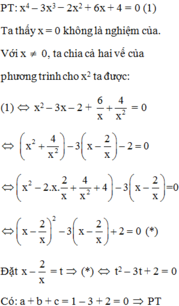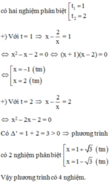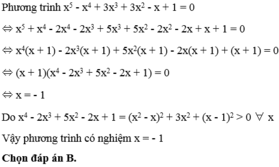Giải phương trình
x4 - 3x3 - 2x2 + 6x + 4 = 0
Hãy nhập câu hỏi của bạn vào đây, nếu là tài khoản VIP, bạn sẽ được ưu tiên trả lời.


Cách 1:
x 4 − 2 x 2 − 3 = 0 ⇔ x 4 − 3 x 2 + x 2 − 3 = 0 ⇔ ( x 2 − 3 ) ( x 2 + 1 ) = 0 ⇔ x 2 − 3 = 0 x 2 + 1 = 0 ⇔ x = ± 3 V n ( x 2 ≥ 0 ⇒ x 2 + 1 > 0 )
Vây phương trình có tập nghiệm S = − 3 ; 3
Cách 2: Đặt t=x2 ( t ≥ 0 ) ta có phương trình t2-2t-3=0 (2)
Ta có a-b+c=1+2-3=0 nên phương trình (2) có 2 nghiệm t1=-1(loại);t2=3(nhận)
Với t2=3 ⇔ x 2 = 3 ⇔ x = ± 3
Vậy phương trình có tập nghiệm S = − 3 ; 3

\(x^4+2x^2-3=0\)\(\Leftrightarrow\left(x^4+2x^2+1\right)-4=0\Leftrightarrow\left(x^2+1\right)^2-2^2=0\Leftrightarrow\left(x^2-1\right)\left(x^2+3\right)=0\Leftrightarrow x^2-1=0\Leftrightarrow x=\pm1\)
Đặt t = x2 ( t ≥ 0 )
pt đã cho trở thành t2 + 2t - 3 = 0
Xét pt bậc 2 ẩn t có a + b + c = 0 nên pt có hai nghiệm t1 = 1(tm) ; t2 = c/a = -3 (ktm)
=> x2 = 1 <=> x = ±1
Vậy ...

1.
a/ \(\Leftrightarrow\left(x+1\right)\left(x^2+3x+2\right)+\left(x-1\right)\left(x^2-3x+2\right)-12=0\)
\(\Leftrightarrow\left(x+1\right)\left(x^2+2\right)+3x\left(x+1\right)-3x\left(x-1\right)+\left(x-1\right)\left(x^2+2\right)-12=0\)
\(\Leftrightarrow2x\left(x^2+2\right)+6x^2-12=0\)
\(\Leftrightarrow x^3+3x^2+2x-6=0\)
\(\Leftrightarrow\left(x-1\right)\left(x^2+4x+6\right)=0\Rightarrow x=1\)
b/ Nhận thấy \(x=0\) ko phải nghiệm, chia 2 vế cho \(x^2\)
\(x^2+\frac{1}{x^2}+3\left(x+\frac{1}{x}\right)+4=0\)
Đặt \(x+\frac{1}{x}=t\Rightarrow x^2+\frac{1}{x^2}=t^2-2\)
\(t^2-2+3t+4=0\Rightarrow t^2+3t+2=0\Rightarrow\left[{}\begin{matrix}t=-1\\t=-2\end{matrix}\right.\)
\(\Rightarrow\left[{}\begin{matrix}x+\frac{1}{x}=-1\\x+\frac{1}{x}=-2\end{matrix}\right.\) \(\Rightarrow\left[{}\begin{matrix}x^2+x+1=0\left(vn\right)\\x^2+2x+1=0\end{matrix}\right.\) \(\Rightarrow x=-1\)
1c/
\(\Leftrightarrow x^5+x^4-2x^4-2x^3+5x^3+5x^2-2x^2-2x+x+1=0\)
\(\Leftrightarrow x^4\left(x+1\right)-2x^3\left(x+1\right)+5x^2\left(x+1\right)-2x\left(x+1\right)+x+1=0\)
\(\Leftrightarrow\left(x+1\right)\left(x^4-2x^3+5x^2-2x+1\right)=0\)
\(\Leftrightarrow\left[{}\begin{matrix}x=-1\\x^4-2x^3+5x^2-2x+1=0\left(1\right)\end{matrix}\right.\)
\(\left(1\right)\Leftrightarrow x^4-2x^3+x^2+x^2-2x+1+3x^2=0\)
\(\Leftrightarrow\left(x^2-x\right)^2+\left(x-1\right)^2+3x^2=0\)
\(\Leftrightarrow\left\{{}\begin{matrix}x^2-x=0\\x-1=0\\x=0\end{matrix}\right.\) \(\Rightarrow\) không tồn tại x thỏa mãn
Vậy pt có nghiệm duy nhất \(x=-1\)

a: \(\Leftrightarrow\left(-x+3\right)\left(x+6\right)=18\)
\(\Leftrightarrow-x^2-6x+3x+18-18=0\)
\(\Leftrightarrow-x\left(x+3\right)=0\)
=>x=0 hoặc x=-3
b: \(\Leftrightarrow x\left(3x^2+6x-4\right)=0\)
\(\Leftrightarrow\left[{}\begin{matrix}x=0\\3x^2+6x-4=0\end{matrix}\right.\Leftrightarrow\left[{}\begin{matrix}x=0\\x^2+2x-\dfrac{4}{3}=0\end{matrix}\right.\)
\(\Leftrightarrow\left[{}\begin{matrix}x=0\\\left(x+1\right)^2=\dfrac{7}{3}\end{matrix}\right.\Leftrightarrow x\in\left\{0;\dfrac{\sqrt{21}}{3}-1;\dfrac{-\sqrt{21}}{3}-1\right\}\)
c: =>x(3x-5)=0
=>x=0 hoặc x=5/3
d: =>(x-2)(x+2)=0
=>x=2 hoặc x=-2

Ta có:

⇔ 20x – 80 – 12 x 2 – 6x > 4x – 12 x 2 – 15x
⇔ 20x – 12 x 2 – 6x – 4x + 12x2 + 15x > 80
⇔ 25x > 80
⇔ x > 3,2
Vậy tập nghiệm của bất phương trình là {x|x > 3,2}

\(a)x^2-9x+20=0 \\<=>(x-4)(x-5)=0 \\<=>x=4\ hoặc\ x=5 \\b)x^2-3x-18=0 \\<=>(x+3)(x-6)=0 \\<=>x=-3\ hoặc\ x=6 \\c)2x^2-9x+9=0 \\<=>(x-3)(2x-3)=0 \\<=>x=3\ hoặc\ x=\dfrac{3}{2}\)
d: \(\Leftrightarrow3x^2-6x-2x+4=0\)
=>(x-2)(3x-2)=0
=>x=2 hoặc x=2/3
e: \(\Leftrightarrow3x\left(x^2-2x-3\right)=0\)
=>x(x-3)(x+1)=0
hay \(x\in\left\{0;3;-1\right\}\)
f: \(\Leftrightarrow x^2-5x-2+x=0\)
\(\Leftrightarrow x^2-4x-2=0\)
\(\Leftrightarrow\left(x-2\right)^2=6\)
hay \(x\in\left\{\sqrt{6}+2;-\sqrt{6}+2\right\}\)

a) Cách 1: Khai triển HĐT rút gọn được 3 x 2 + 6x + 7 = 0
Vì (3( x 2 + 2x + 1) + 4 < 0 với mọi x nên giải được x ∈ ∅
Cách 2. Chuyển vế đưa về ( x + 3 ) 3 = ( x - 1 ) 3 Û x + 3 = x - 1
Từ đó tìm được x ∈ ∅
b) Đặt x 2 = t với t ≥ 0 ta được t 2 + t - 2 = 0
Giải ra ta được t = 1 (TM) hoặc t = -2 (KTM)
Từ đó tìm được x = ± 1
c) Biến đổi được ![]()
d) Biến đổi về dạng x(x - 2) (x - 4) = 0. Tìm được x ∈ {0; 2; 4}

Đặt \(x^2=t\) \(\left(t\ge0\right)\)
\(\Rightarrow t^2-2t-3=0\\ \Leftrightarrow\Delta=\left(-2\right)^2-4.1.\left(-3\right)=16\\ \Rightarrow\left\{{}\begin{matrix}t_1=\dfrac{2+\sqrt{16}}{2.1}=3\\t_2=\dfrac{2-\sqrt{16}}{2}=-1\end{matrix}\right.\)
\(\Rightarrow t=3\) vì \(t\ge0\)
\(\Rightarrow x^2=3\\ \Rightarrow\begin{matrix}x=\sqrt{3}\\x=-\sqrt{3}\end{matrix}\)
Đặt t = x² (t ≥ 0)
Phương trình tương đương:
t² - 2t - 3 = 0
Ta có: a - b + c = 1 - (-2) - 3 = 0
Phương trình có hai nghiệm:
t₁ = -1 (loại)
t₂ = 3 (nhận)
Với t₂ = 3
⇔ x² = 3
⇔ x = √3; x = -√3
Vậy S = {-√3; √3}



\(x^4-3x^3-2x^2+6x+4=0\)
\(\Leftrightarrow x^4-2x^3-2x^2-x^3+2x^2+2x-2x^2+4x+4=0\)
\(\Leftrightarrow x^2\left(x^2-2x-2\right)-x\left(x^2-2x-2\right)-2\left(x^2-2x-2\right)=0\)
\(\Leftrightarrow\left(x^2-x-2\right)\left(x^2-2x-2\right)=0\)
\(\Leftrightarrow\left(x+1\right)\left(x-2\right)\left(x-1-\sqrt{3}\right)\left(x-1+\sqrt{3}\right)=0\)
\(\Leftrightarrow\left[{}\begin{matrix}x=-1\\x=2\\x=1+\sqrt{3}\\x=1-\sqrt{3}\end{matrix}\right.\)